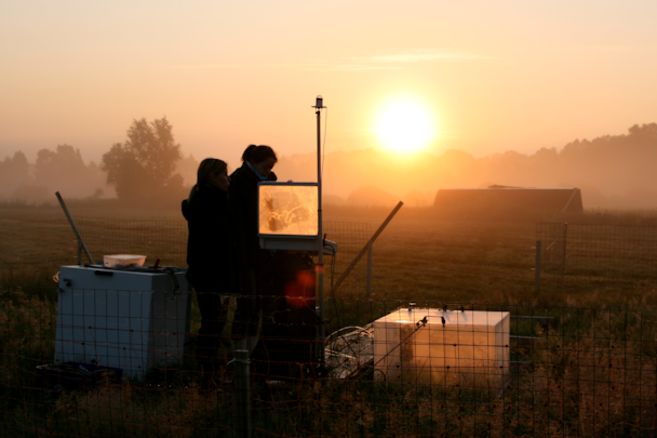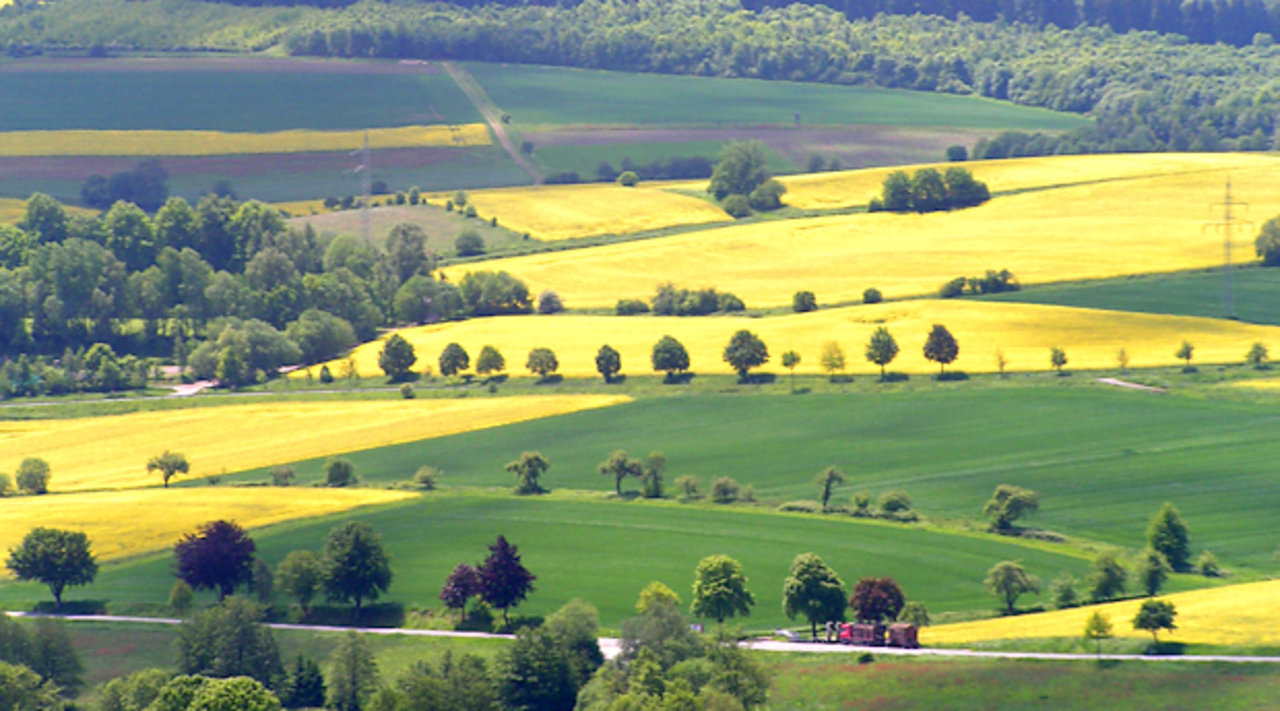

Institut für
AK Agrarklimaschutz
Projekt
GHG-Europe

GHG-Europe Treibhausgasmanagement in europäischen Landnutzungssystemen
Die terrestrischen Ökosysteme sind wesentliche Quellen und Senken von Treibhausgasen in Europa. Das vom Thünen Institut für Agrarklimaschutz koordinierte EU-Projekt „GHG-Europe“ hat diese Quellen und Senken verschiedener Landnutzungssysteme quantifiziert und abgeschätzt, welche Potentiale es gibt, Treibhausgase in Europa zu reduzieren. Dazu müssen anthropogene und natürliche Faktoren in der Treibhausgasbilanz voneinander geschieden werden. Unser Projekt lief im Verbund mit insgesamt 41 Partnern in 15 europäischen Ländern.
Hintergrund und Zielsetzung
Das ehrgeizige Projekt wurde von der Europäischen Kommission von Januar 2010 bis September 2013 mit insgesamt 6.7 Mio. € gefördert. Weitere geschätzte 12 Mio. € flossen aus nationalen und universitären Mitteln ein. Im GHG-Europe-Projekt wurde untersucht, welchen Anteil unterschiedliche Landnutzungssysteme an den Emissionen der drei wichtigsten Treibhausgase Kohlendioxid (CO2), Lachgas (N2O) und Methan (CH4) haben. Grundlage für die integrierte Datenanalyse sind Messungen an über 100 kontinentalen Messstationen und zusätzliche Langzeitversuche, verteilt über alle Klimaregionen und Ökosysteme Europas. Die Emissionen von Treibhausgasen aus Böden standen im Mittelpunkt. Parallel dazu wurden atmosphärische Messungen von hohen Messtürmen genutzt um die „Atmung der Biosphäre“ zu analysieren.
Vorgehensweise
Die Daten des Messnetzes flossen in komplexe Modelle ein. Mit ihnen lässt sich das Verhalten der terrestrischen Biosphäre unter veränderten Klimabedingungen vorhersagen. Zusätzlich untersuchten wir mit sozioökonomischen Modellen die Wechselwirkungen von ökonomischer Entwicklung, Landnutzungsszenarien und Treibhausgasemissionen und entwickeln Szenarien für die zukünftige Treibhausgasbilanz der Biosphäre Europas. Erstmals wurden in einem Forschungsprojekt die drei wichtigsten Treibhausgase CO2, N2O, CH4 auf europäischer Skala gemeinsam untersucht. Dies ist besonders wichtig, um die Rolle der Land- und Forstwirtschaft für den Klimaschutz zu verstehen.
Ergebnisse
Updates of the European carbon and greenhouse gas budget confirmed the previously published values. Europe remains a net carbon sink, which is more than compensated by N2O and CH4 emissions from agriculture. These updates do not fully include yet the greenhouse gas (GHG) sources from drained organic soils (peat soils). Despite a high uncertainty in the area and drainage status anthropogenic emissions from drained organic soils are likely underestimated by at least factor two or three in the European greenhouse gas inventory under the United Nations Framework Convention on Climate Change.
For the first time, European estimates have been made based on fully consistent in spatio-temporal driver fields with common time periods, frequency, and spatial resolution. New driver fields have been developed for important direct and indirect human drivers: nitrogen deposition, agricultural management, and age class distribution in forests. The driver fields are publically available for further use at the project database.
The classical approach to constrain the terrestrial carbon and greenhouse gas budget by independent top-down and bottom-up methods has again been successfully applied at European scale. The application at regional scale, however, revealed considerable uncertainty in the atmospheric top-down method so that so far, only the bottom-up method was considered robust to monitor success in GHG mitigation at regional scale.
Management effects override the impact of interannual variability in climate drivers on the ecosystem carbon balance when more than 20% of the net primary production is harvested. This threshold is likely exceeded in most land-use systems and regions of Europe except for pastures and young forests.
Land-use changes have occurred on 25% of the European land area since 1900 and on 15% since 1950. There is a strong asymmetry in soil reactions to land-use change. Soils lose carbon fast within 20 years but take more than 100 years to recover. The long legacy of land-use change effects on soil carbon may mask effects of recent management changes.
Sensitivity and attribution analyses based on data synthesis and modelling agreed in the most effective options for GHG mitigation. They confirmed previous scientific findings and policy recommendations for mitigation measures in croplands, grasslands, forests and managed peatlands.
Scenarios of future carbon and GHG emissions were developed. They demonstrate the importance of consistent cross-sectoral policies for agriculture, energy and other fields that affect land-use decisions so that clear incentives for low emission land-use systems can be set up. Land-use decisions, economic and political drivers will remain the dominant drivers of European carbon and greenhouse gas fluxes in the coming decades.
Thünen-Ansprechperson

Thünen-Beteiligte
Beteiligte externe Thünen-Partner
-
Institut national de recherche pour l’agriculture, l’alimentation et l’environnement (INRAE)
(Paris, Toulouse, Montpellier, Avignon, Ivry-sur-Seine, Clermont-Ferrand, Rennes, Thiverval-Grignon, Dijon, Orleans, Bordeaux, Pierroton, Frankreich) -
Swedish University of Agricultural Science - SLU
(Uppsala, Lysekil, Schweden) -
University College Dublin
(Dublin, Irland) - University of Copenhagen
(Kopenhagen, Helsingoer, Dänemark) -
Centre d'Etudes Spatiales de la BIOsphère (CESBIO)
(Toulouse, Frankreich) -
University of Aberdeen
(Aberdeen, Großbritannien (inkl. Nordirland)) -
Freie Universität Amsterdam
(Amsterdam, Niederlande) -
Forest Research and Management Institute - ICAS
(Bukarest, Ilfov, Rumänien) - Wageningen University & Research (WUR)
(Wageningen, Niederlande)
Geldgeber
-
Europäische Union (EU)
(international, öffentlich)
Zeitraum
1.2010 - 9.2013
Weitere Projektdaten
Projektfördernummer: 244122
Förderprogramm: EU – FP7 – Thematic Priority "Environment (including Climate Change)"
Projektstatus:
abgeschlossen
Publikationen
- 0
Bouriaud O, Don A, Janssens IA, Marin G, Schulze E-D (2019) Effects of forest management on biomass stocks in Romanian beech forests. For Ecosyst 6:19, DOI:10.1186/s40663-019-0180-4
- 1
Dechow R, Franko U, Kätterer T, Kolbe H (2019) Evaluation of the RothC model as a prognostic tool for the prediction of SOC trends in response to management practices on arable land. Geoderma 337:463-478, DOI:10.1016/j.geoderma.2018.10.001
- 2
Szoboszlay M, Dohrmann AB, Poeplau C, Don A, Tebbe CC (2017) Impact of land-use change and soil organic carbon quality on microbial diversity in soils across Europe. FEMS Microbiol Ecol 93(12):1-12, DOI:10.1093/femsec/fix146
- 3
Erb K-H, Luyssaert S, Meyfroidt P, Pongratz J, Don A, Kloster S, Kuemmerle T, Fetzel T, Fuchs R, Herold M, Haberl H, Jones CD, Marin-Spiotta E, McCallum I, Robertson E, Seufert V, Fritz S, Valade A, Wiltshire A, Dolman AJ (2016) Land management: data availability and process understanding for global change studies. Global Change Biol 23(2):512-533, DOI:10.1111/gcb.13443
- 4
Nyawira SS, Nabel JE, Don A, Brovkin V, Pongratz J (2016) Soil carbon response to land-use change: evaluation of a global vegetation model using observational meta-analyses. Biogeosciences 13:5661-5675, DOI:10.5194/bg-13-5661-2016
- 5
Luyssaert S, Jammet M, Stoy PC, Estel S, Pongratz J, Ceschia E, Churkina G, Don A, Erb K-H, et al (2014) Land management and land-cover change have impacts of similar magnitude on surface temperature. Nat Clim Change 4:389-393, DOI:10.1038/NCLIMATE2196
- 6
Leppelt T, Dechow R, Gebbert S, Freibauer A, Lohila A, Augustin J, Drösler M, Fiedler S, Glatzel S, Höper H, Järsveoja J, Laerke PE, Maljanen M, Mander Ü, Mäkiranta P, Minkkinen K, Ojanen P, Regina K, Strömgren M (2014) Nitrous oxide emission budgets and land-use-driven hotspots for organic soils in Europe. Biogeosciences 11:6595-6612, DOI:10.5194/bg-11-6595-2014
- 7
Poeplau C, Don A (2014) Soil carbon changes under Miscanthus driven by C4 accumulation and C3 decomposition - toward a default sequestration function. GCB Bioenergy 6(4):327-338, DOI:10.1111/gcbb.12043
- 8
Poeplau C, Don A (2013) Auswirkung von Miscanthus-Anbau auf den Bodenkohlenstoff - Entstehung einer C-Sequestrierungsfunktion für die gemäßigten Breiten : [Abstract für]: Jahrestagung der Deutschen Bodenkundlichen Gesellschaft (07.-12.09.2013 in Rostock).
- 9
Dechow R, Gebbert S, Franko U, Kätterer T, Kolbe H (2013) Estimating partition coefficients in the soil carbon model RothC using long term experiments and Bayesian calibration. In: International workshop SOMpatic : Rauischholzhausen, Germany, Nov 20th - 22nd 2013 ; abstracts. p 1
- 10
Don A, Poeplau C, Vesterdal L, Fuchs R, Herold M, Gebbert S (2013) Impact of land-use changes on the European carbon balance. In: Book of abstracts : Open Science Conference ; Greenhouse Gas Management in European Land Use Systems ; 16.-18. September 2013, Antwerp, Belgium. Antwerp: University of Antwerp
- 11
Leppelt T, Dechow R, Gebbert S, Freibauer A (2013) Modelling nitrous oxide emissions from organic soils in Europe. Geophys Res Abstr 15:7421
- 12
Don A, Osborne B, Hastings A, Skiba U, Carter MS, Drewer J, Flessa H, Freibauer A, Hyvönen N, Jones MB, Lanigan GJ, Mander Ü, Monti A, Djoma SN, Valentine J, Walter K, Zegada-Lizarazu W, Zenone T (2012) Land-use change to bioenergy production in Europe: implication for the greenhouse gas balance and soil carbon. GCB Bioenergy 4(4):372-391, DOI:10.1111/j.1757-1707.2011.01116.x
- 13
Poeplau C, Don A (2012) Sensitivity of soil organic carbon stocks and fractions to different land-use changes across Europe. Geoderma 192:189-201, DOI:10.1016/j.geoderma.2012.08.003
- 14
Poeplau C, Don A, Vesterdal L, Leifeld J, Wesemael B van, Schumacher J, Gensior A (2011) Temporal dynamics of soil organic carbon after land-use change in the temperate zone - carbon response functions as a model approach. Global Change Biol 17(7):2415-2427, DOI:10.1111/j.1365-2486.2011.02408.x

